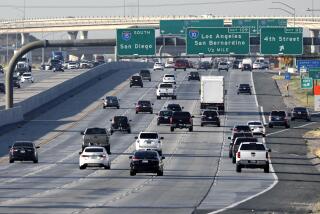Focus on DUIs shifts to drugs
- Share via
Russ Clark, a motorcycle officer with the Long Beach police, says he’s arrested “potheads, hard-core methamphetamine addicts, even nurses and doctors under the influence of drugs.”
In his pursuit of law-breaking motorists, the 26-year veteran of the department has pulled over weaving vehicles thick with marijuana smoke and drivers so high “they were moving in slow motion.”
“It was like right out of a Cheech and Chong movie,” he says.
He’s snared twitching meth addicts driving erratically and motorists so wasted on muscle relaxers they could hardly stand.
While incidences of drunk driving have declined over the years, thanks in part to organizations such as Mothers Against Drunk Driving, driving under the influence of drugs has increased, reports Marilyn Huestis at the National Institute on Drug Abuse in Rockville, Md.
To battle the problem, researchers are scrambling to develop uniform procedures that would allow police to easily screen motorists suspected of being under the influence of drugs.
One procedure involves a saliva test that could be done quickly in the field with a swab. It would not require police to take a suspect to a hospital or to jail for blood or urine samples, Huestis says.
Australia and some European countries are ahead of the U.S. in screening efforts. Authorities in Victoria, Australia, have done saliva testing to determine marijuana and methamphetamine use and are planning to add screening for Ecstasy, says Huestis, a toxicologist and chief of the drug abuse institute’s Chemistry and Drug Metabolism program. “We have been playing catch-up,” she says.
James Frank of the National Highway Traffic Safety Administration cautions that testing is still in the early stages. He says testing may be completed in early 2007.
Huestis says that if the screening is approved in the U.S. the initial roadside screening would be the first step to detect drugs. After a positive result, police would have to take the suspect to a hospital or to jail for a more detailed blood or urine confirmation test.
“We know that marijuana is the drug that shows up most often, since it is the most commonly abused drug in the U.S.,” says Huestis. But the use of powerful stimulants like methamphetamines and cocaine raises even bigger concerns, she says.
“We are seeing a tremendous number of accidents that occur when people are coming down from stimulants,” she says. They are fatigued, and if they get behind the wheel they can fall asleep. If they are still high, they may drive recklessly, Huestis adds.
In February, a mother of three in Olympia, Wash., was sentenced to 17 months in prison for driving under the influence of methamphetamines after she caused a crash that paralyzed her 4-year-old son.
Estimates on the number of drug-related accidents vary because researchers admit it’s hard to nail down which fatalities, accidents or incidents involve people driving under the influence of drugs. The problem is that many police departments don’t differentiate between cases involving alcohol or drugs.
The National Center for Injury Prevention and Control reports that in 2004 about 1.4 million drivers were arrested for allegedly being under the influence of alcohol or drugs, according to the U.S. Department of Justice.
Researchers at the drug abuse institute, the highway safety administration and other such groups are often left with anecdotal information and insufficient hard data. While a breathalyzer test at the side of the road can determine a driver’s blood alcohol content, the only way to determine if someone is under the influence of drugs is a blood or urine test, which has to be done at a hospital or jail facility.
As a result, officers who stop a person suspected of impaired driving test first for alcohol. If the roadside test is positive, they generally don’t seek a drug test because of the inconvenience, says Long Beach Police Sgt. David Cannan.
Dr. Federico Vaca, director of UC Irvine’s Center for Trauma and Injury Prevention Research, says drugs play a role in accidents far too often. “Emergency room doctors often see young drivers hurt in accidents that involve alcohol and drugs.” And with a surge in meth use, Vaca says, the incidents could increase.
“Mixing speed [methamphetamines] with alcohol is a formula for disaster,” Vaca says.
*
Jeanne Wright can be reached at J[email protected].
More to Read
Sign up for Essential California
The most important California stories and recommendations in your inbox every morning.
You may occasionally receive promotional content from the Los Angeles Times.










